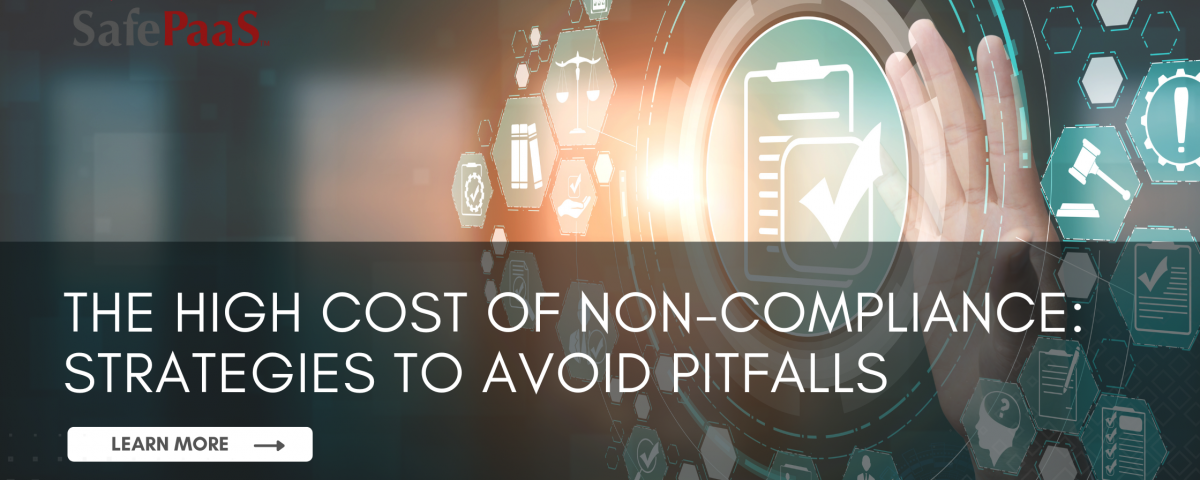The high cost of non-compliance


The High Cost of Non-Compliance: Strategies for Ensuring Compliance and Avoiding Pitfalls
Compliance is often perceived as a hassle. But failing to meet regulatory requirements can easily cost your business millions.
To stay competitive, businesses have increasingly adopted connected technology, inadvertently forming a vulnerable network of unsecured systems. This unsecured network acts as an ideal entry point for bad actors.
Regulatory compliance is intricately tied to IT security because regulations mandate implementing specific security measures and controls to safeguard sensitive data, transactions, and systems. Non-compliance exposes organizations to legal and financial repercussions and increases the risk of data breaches and cyberattacks, emphasizing the critical relationship between regulatory compliance and IT security.
"A robust compliance function is akin to having a best-of-breed cybersecurity solution and is one of the most vital components of your business."
What are Compliance Costs?
Compliance entails conforming to industry standards, policies, rules, and legal requirements to ensure your business adheres to national and international regulations. IT security and controls tend to incur the highest costs among all other compliance costs.
Regulations aim to formalize best practices to prevent fraud and enhance security across your business to instill confidence in stakeholders. A particular focus of regulators is gaining visibility and control over the IT environment.
To comply, your organization must show who has access to applications, systems, and data, determine the rightful access, and monitor their associated activities. Additionally, many regulations call for implementing IT controls to enforce corporate policies concerning:
- Sarbanes-Oxley Act (SOX) and other variations adopted by countries like Japan, Canada, and the UK
- Federal Information Security Management Act (FISMA)
- Health Insurance Portability and Accountability Act (HIPAA)
- Payment Card Industry Data Security Standard (PCI DSS)
- EU's General Data Protection Regulation (GDPR)
The Cost of Non-Compliance
Compliance costs encompass every resource your organization dedicates to ensuring adherence to relevant regulations. This includes the time spent developing comprehensive policies and procedures, recordkeeping, and integrating software and databases for digital transactions and processes.
Despite the associated expenses, the price of non-compliance is considerably higher. In addition to fines, your organization will find that the true cost of non-compliance also encompasses disruption to your business and damage to your reputation.
Financial Misstatement costs: Financial misstatements can carry significant compliance costs and repercussions for your organization. Misstatements refer to errors, omissions, or fraudulent activities that can lead to inaccuracies in your company's financial reporting. Those inaccuracies can manifest in various forms, including mistakes in accounting entries, intentional manipulation of financial data, or inadequate disclosure of relevant information.
It's important to recognize that financial misstatements can have wide-ranging consequences for your organization, affecting your finances, legal standing, reputation, and operational efficiency. To avoid financial misstatements, your organization should implement strong internal controls and effective compliance measures to safeguard against non-compliance. These measures are vital for detecting and preventing financial misstatements and promptly addressing them when they occur.
Business Disruption: When your organization falls into non-compliance, you often face immediate disruptions as you scramble to implement changes. These changes may require adopting new processes, leading to further disruption during the transitional period.
Data Breaches: The evolving complexity of data protection regulations heightens the risk of data breaches, data loss, cyberattacks, or even insider threats.
Reputational Damage: One of the most underestimated costs of non-compliance is damaging your organization's reputation. And repairing your reputation and winning back your customer's trust and loyalty can be a slow process.
Revenue Loss: Regulatory violations substantially impact your organization's revenue, affecting the bottom line.
So, how can your organization mitigate the cost of non-compliance?
Access Governance for Assured Compliance
Access governance can play a pivotal role in minimizing non-compliance costs. By implementing strong access control policies and procedures, access governance ensures that only authorized individuals can access sensitive data, transactions, and systems, reducing the risk of data breaches, regulatory violations, and security incidents.
Through automated user provisioning and de-provisioning processes, access governance enhances security and streamlines administrative tasks, reducing the burden and associated compliance costs. Access governance also simplifies audits and reporting, enabling your organization to identify and correct non-compliance issues before they escalate, saving you time and resources that would otherwise be spent on legal fines, reputation damage control, and data recovery efforts.
Access governance is a proactive and cost-effective measure to safeguard your organization's integrity, compliance, and financial well-being and forms the fundamental basis for ensuring security and compliance within your organization.
Here's how you can leverage access governance to ensure compliance:
Enforcement of Access Policies: Access governance systems enforce access policies and ensure users have access rights based on their roles and responsibilities, helping your organization comply with strict access control regulations.
Access Reviews and Certification: Automated access reviews and certification processes enable your organization to regularly review and certify user access, ensuring compliance during audits.
Audit Trail Generation: Policy-based access governance systems generate comprehensive audit trails that encompass user access, process changes, configurations, data transactions, and more. These audit trails are the backbone of an organization's efforts to ensure compliance, bolster security, and facilitate continuous improvement in its digital operations.
Policy-Based Access Control (PBAC): Through control automation, your organization can adopt PBAC models that assign access privileges based on defined policies and rules, aligning user access with their ability to make changes to transactions, data, and configurations, and thereby minimizing instances of unauthorized access.
Continuous Monitoring: Automated controls continuously monitor user activities and access rights in real-time, helping your organization quickly identify and address any unauthorized or suspicious activities occurring with changes to transactions, configurations, and master data.
Incident Detection and Response: Control automation solutions can trigger alerts and responses to potential compliance violations or security incidents, enabling swift remediation.
Policy Enforcement: Access governance systems enforce predefined policies and rules for access management, ensuring users adhere to requirements.
Automated Reporting: Automation simplifies the process of generating compliance reports, which is essential for audit and regulatory reporting.
Segregation of Duties Control: Access governance solutions can automate SoD checks to prevent conflicts of interest or fraud, which is crucial for compliance.
Documentation and Accountability: Automated controls maintain comprehensive records of access requests, approvals, and changes, establishing a clear audit trail and ensuring accountability.
Streamlined Audit Processes: Access governance and control automation streamline audit processes, expediting audits and ensuring efficient compliance assessment.
Policy Updates and Adaptation: Automation facilitates the timely implementation of policy updates and changes to comply with evolving regulations.
Integrating access governance and control automation into your organization's compliance strategies can reduce non-compliance risk, streamline compliance-related processes, enhance security, and demonstrate your commitment to meeting compliance obligations during audits.
Hopefully, this blog has helped you recognize that compliance is not just a bureaucratic hassle; it's a crucial investment in your organization's security, reputation, and financial stability. The costs associated with compliance efforts, including policy development, recordkeeping, and software integration, are a small price compared to the potential consequences of non-compliance. Business disruptions, data breaches, reputational damage, and revenue losses can be far more detrimental.
Access governance emerges as a powerful compliance ally offering automated controls, continuous monitoring, and streamlined audit processes that reduce non-compliance risk and demonstrate your commitment to regulatory obligations. By embracing access governance and control automation, your organization can fortify its security posture, uphold its integrity, and thrive in an increasingly regulated business landscape.
Recommended Resources

Internal Controls and Segregation of Duties
Internal controls and control frameworks are closely linked to Governance, Risk Management, and Compliance. Organizations use a control framework and internal controls to align their business activities with strategic goals, manage risks effectively, and adhere to regulatory and compliance requirements.

SOX Compliance Audit
Some organizations are new to Sarbanes-Oxley (SOX) Act requirements, while others are seasoned professionals. No matter your GRC strategy or the maturity of your SOX program, it can likely be made more efficient and less painful. Read on to learn more about SOX compliance requirements and what you can do to improve your next SOX compliance audit.

Why Automate Internal Controls
Automated controls don’t just make things easier and safer. Automated controls enhance your financial control posture and workflow. Additionally, they improve your overall operational efficiency.

